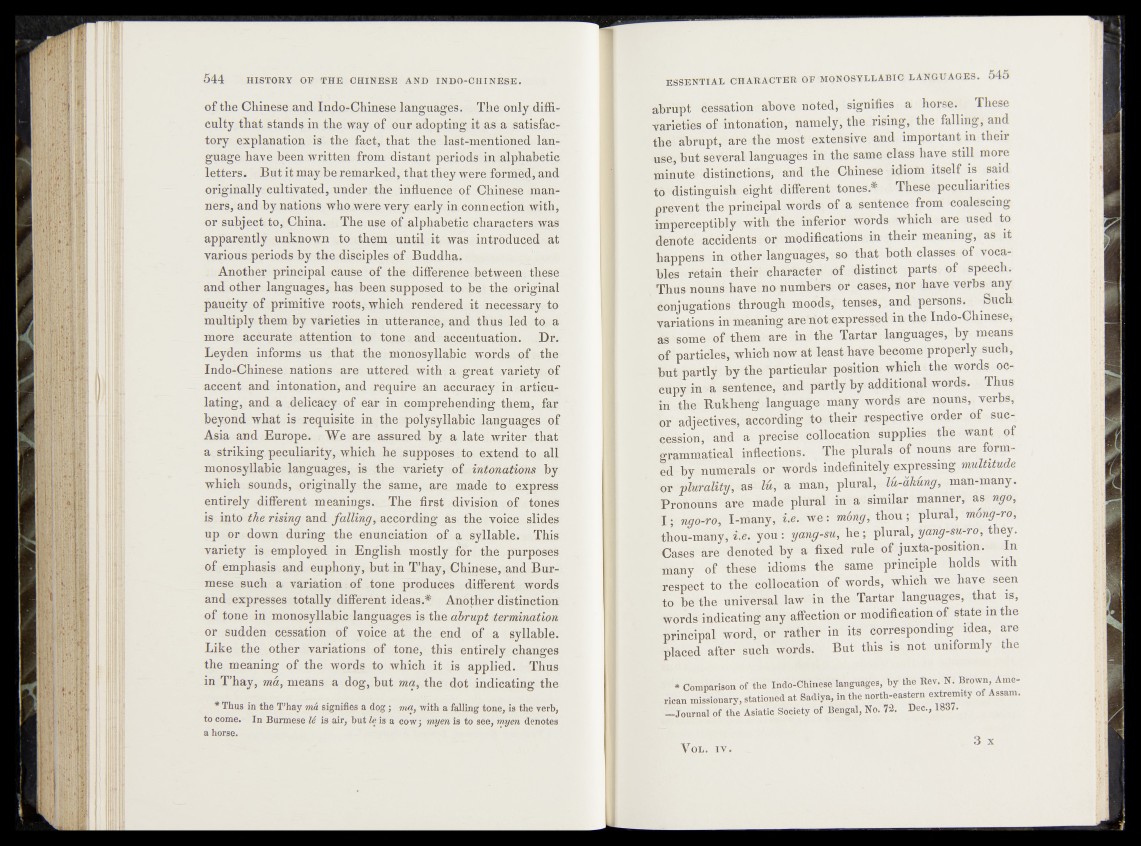
of the Chinese and IndorChinese languages... The only difficulty
that stands in the way . of our adopting it as a satisfactory
explanation is the fact,, that the last-mentioned language
have been written from distant periods in alphabetic
letters. But it may be remarked, that they were, formed, and
originally; cultivated, under, the influence of Chinese manners,
and by nations who were very early inconnection iwith,
or subject to,; China. The use of .alphabetic characters, was
apparently unknown to them until it was introduced at
various periods by the disciples of Buddha.
. Another principal cause of the difference between, these
and other languages, has been supposed to be the original
paucity of primitive roots, which rendered it necessary to
multiply them by varieties in utterance, and thus led to a
more accurate attention to tone| and accentuation. Dr.
Leyden informs us that the, monosyllabic words, of^the
Indo-Chinese nations are uttered with, a great variety, of
accent and intonation, and reqjii|pe&an accura^. in ; afitieu-
lating, and a delicacy of ear in comprehending them, fa/rf
beyond what is requisite in the polysyllabic languages of
Asia and Europe. . We are assured by a late writer that
a striking peculiarity, which he supposes^to extend to all
monosyllabic languages, is the variety oiy< intonations by
which sounds, originally the Same, are. „made :.to express
entirely different meanings.; The first, division of .tones
is into the rising and falling, according as the ; voice slides
up or down during the enunciation of a sellable. This
variety is employed in English mostly ,ror; the purposes
of emphasis and euphony, but in T’hay,vChinese,.and Burmese
such a variation of tone produces different words
and expresses totally different ideas.* Another distinction
of tone in monosyllabic languages is the abrupt termination
or sudden cessation of voice at the end of a syllable.
Like the other variations of tone, this entirely changes
the meaning of the words to which it is applied. Thus
in T’hay, m'a, means a dog, but ma, the dot indicating the
* Thus in the T’hay m& signifies a dog; ma, with a falling tone, is the verb,
to come. In Burmese 14 is air, but le is a cow j myen is to see, myen denotes
a horse.
abrupt Cessation above notedsignifies a horse. These
varieties of intonation, namely, the rising, the falling, and
the abrupt, are the most extensive and important in their
use, but several languages in the same class have still more
minute distinctions', and the Chinese • idiom itself is said
to. distinguish eight different tones* These peculiarities
prevent the principal words of a sentence from coalescing
imperceptibly with the inferior words which are used to
denote accidents or modifications in their meaning, as it
happens in other languages, so ’that both classes; of vocables
retain their character of distin# ipartsy^of speech.
Thus nouns have? no numbers or cases, nor have verbs any
Conjugations through moods, tenses, and, persons. Such
variations in meaning.are hot.expressed in the Indo-Chinese*
as gome of them are in the Tartar languages, by means
of particles, which now at least have become properly such,
but partly by the particular position which the words oer*
eupy in ,a sentence, and partly by additional words. Thus
in the Eukheng language many words are nouns, verbs,
or adjectives, according to. their respective order of suc-
Ëhession, and a pTCçïsë collocation supplies the want of
grammatical inflections. The plurals of nouns are form-
|dr by numerals or words indefinitely- expressing multitude
or plurality, as lu, a man, plural, lu-ahung, man-many.
Pronouns are made plural in a similar manner, as ngo,
I ; ngo-ro, I-many, i.e. we: móng, thou ; plural, mbng-ro,
thou-many, i.e. yóu: yang-su, he ; plural, yarig-su-ro, they.
Cases are denoted by a fixed rule of juxta-position. In
many of these idioms th é ‘same principle holds with
respect to the collocation of words, which we have seen
to he the universal law in the Tartar languages, that is,
words indicating any affection or modification of state m the
principal word, or rather in?ÉÉ corresponding idea, are
placed after such words. But this is not uniformly the
* Comparison of the Indo-Chinese languages, by the Rev. N. Brown, American
missionary, stationed at Sadiya, in the north-eastern e te r n ity of Assam.
—Journal of the Asiatic Society of Bengal, No. 72. Dec., 1837.
Vol. IV. 3 x